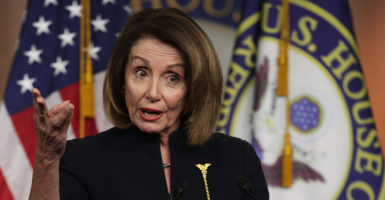House Speaker Nancy Pelosi is reportedly readying a plan that could limit Americans’ access to lifesaving medicines and impede the development of new treatments for deadly and debilitating diseases.
Her plan, a summary of which was leaked last week, would double down on the failures of existing government policies that have contributed to higher health care costs.
It would establish a system in which the U.S. government bases prices for cutting-edge drug treatments on those set by foreign governments.
According to the leaked description of a drug price negotiation bill (H.R. 3), the measure would set an upper price limit at 1.2 times a drug’s average price in six other countries (Australia, Canada, France, Germany, Japan, and the United Kingdom).
The health and human services secretary then would seek to “negotiate” prices below that upper limit for as many as 250 drugs each year.
The price resulting from these “negotiations” would be applied throughout the U.S. market. The government would require manufacturers to offer that price to private payers, as well as to public programs. Manufacturers that deviated from that price would face massive civil monetary penalties.
A manufacturer that declined to negotiate the price of any of its products would incur stiffer penalties—an excise tax equal to 75% of the revenue it derived from that product in the preceding year.
The bill represents an unprecedented exercise of raw government power.
The federal government already imposes price curbs across a range of programs, requiring manufacturers to pay the government rebates in Medicaid, discounts in Medicare, and to make various price concessions in the Veterans Affairs health system.
These provisions all are confined to federal programs, but nonetheless have distorted drug prices throughout the health sector.
It’s one thing for the government to dictate the prices it pays in programs it finances. It is quite another for the government to impose a price for a product’s private sales.
Aggressive government price-setting has damaged innovation and limited access to new treatments in all six of the countries whose price controls the bill would import.
If the U.S. adopts price controls, it risks the same results.
Access to new drugs is much greater in the U.S. than in countries with price controls, in part because it has shunned price controls.
Of new active substances introduced between 2011 and 2018, 89% are available to Americans, compared with 62% in Germany and 60% in the United Kingdom. One-half or more of these new therapies are unavailable to Australian, Canadian, French, and Japanese patients.
This lack of access can have damaging effects. A study by IHS Markit examined outcomes for non-small cell lung cancer, the leading cause of cancer mortality in the U.S. and the world.
The report compared how Americans with that disease fared, compared with citizens of other highly developed countries, including Australia, Canada, France, and the U.K.
The study concluded that Americans gained 201,700 life years as a result of faster access to new medicines. Half those gains would have been wiped out, the study found, if Americans had the same limited access to those treatments as patients in other countries.
Patients will be worse off if Washington emulates the price control regimes of foreign governments.
Countries with price controls also suffered a decline in pharmaceutical research and development.
In 1986, European firms led the U.S. in spending on pharmaceutical research and development by 24%. After the imposition of price control regimes, they fell behind. By 2015, they lagged the U.S. by 40%.
If the U.S. emulates the European price-setting example, innovation almost certainly will suffer.
Trading innovation and access to new medicines in exchange for lower prices on existing products may strike some as a good deal. But according to the president’s Council of Economic Advisers, it wouldn’t be.
The council concluded that while price controls might save money in the short term, they would cost more money in the long run. Government price-setting, it wrote, “makes better health care costlier in the future by curtailing innovation.”
As the public debate over health care has become more contentious, it also has become more clarifying.
On one side are those who advocate increased federal control over the allocation of medical goods and services—price controls on drugs, “Medicare for All,” and more federal spending on failing programs.
On the other side are those who acknowledge problems with the health care system (many of them caused or worsened by government intervention), but instead advocate for reforms that build on its best features.
Among the things worth preserving in the U.S. are innovations that save lives and that cure or ameliorate chronic diseases. Governments do not produce those advances; markets do.
Policymakers face a choice between consumer-centered reform that advances innovation and saves lives and government policies that restrict treatment options for patients.
The Pelosi drug-pricing bill makes the wrong choice.

























